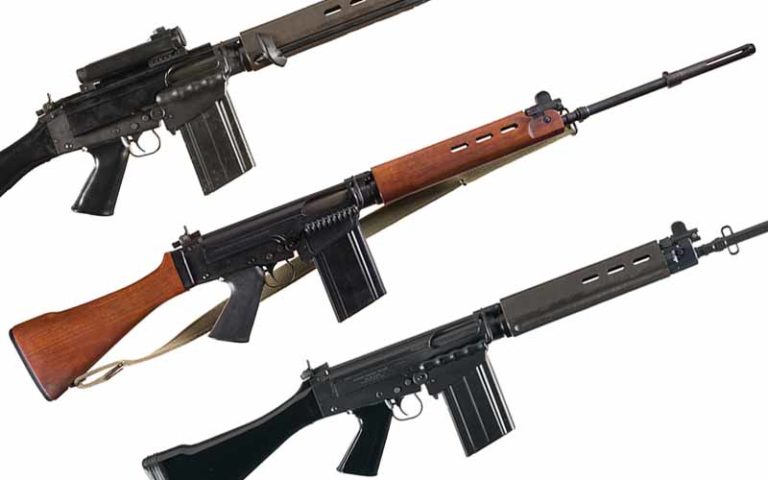
Originally intended to use an intermediate cartridge, the FN FAL ended up sparking the battle rifle trend that would see them featured in global conflicts for decades to come.
FN FAL Quick Facts:
- FAL=Fusil Automatique Léger= Light Automatic Rifle
- 7.62x51mm Rifle Using Short-Stroke Gas Piston System
- First Prototype Designed By Dieudonné Saive In 1946
- Adopted By Over 90 Countries
- Seen Use In Conflicts From Mid-1950s To Today
Plagued by politics and bureaucracy, the development of the FN FAL seemed doomed to fail from the start. While it may have missed out on realizing its full potential, the FN FAL still ended up being one of the most successful military rifles ever produced, likely only taking second place in terms of proliferation to the Kalashnikov. The FAL’s widespread adoption helped start the trend of battle rifles chambered in full-power cartridges which would be featured front and center in the world’s conflict zones from the 50s to the 80s and beyond. While the FN FAL has mostly fallen out of mainline military service, it is still appreciated around the globe by combatants and firearms enthusiasts alike for its rugged reliability, good ergonomics and raw sex appeal.

The Post War Dream
In the wake of WWII, it was no secret that the Germans had come up with a winning design with their StG 44. As the first practical execution of the assault rifle concept, it served as inspiration in both the East and the West for the respective nations’ next infantry weapon. The intermediate caliber, the select-fire rifle that the USSR came up with was the AK of course, but what is often forgotten is that the FN FAL began its life the same way.
The first FAL prototype produced in 1946 was chambered in 8mm Kurz, the same round used in the StG 44 that would go on to be known as the father of all intermediate cartridges. If development would have continued down this path, the FN FAL would have likely been adopted chambered in .280 British, resulting in a rifle that would have handled similarly to an AK—more controllable full-auto fire, larger magazines and lighter ammo. Instead, politics and American stubbornness forced the FN FAL to become what we know today as a battle rifle instead of an assault rifle, accidentally starting a weapon trend that would come to dominate small arms proliferation until at least the 1980s.

FAL Development
Work on the FAL began in Belgium at FN Herstal where its development was headed by Dieudonné Saive, John Browning’s old protégé who helped make the Hi-Power such a success. Development began almost immediately following WWII in 1946, but the design was not considered finished until 1951 and not formally adopted by any military until the Canadians did so in 1955 in the guise of their slightly modified C1.
The drive behind the FN FAL’s development was NATO standardization. Much like the STANAG concept of standardized magazines and ammunition that was introduced in the 1980s, following WWII NATO was also attempting to standardize all member states on the same weapon platform and cartridge. Unfortunately for them, it didn’t quite go as planned. The United States insisted that the standard NATO cartridge must maintain the ballistic capabilities of .30-06, essentially forcing NATO’s adoption of 7.62x51mm. It was this demand that resulted in the FAL’s redesign into what we know it as today—a battle rifle chambered for the full-power 7.62 NATO round. This change was predicated on the assumption that the United States would then be willing to adopt the FN FAL as their standard infantry rifle as well, but again America decided to go their own way and adopt the M14.

To NATO’s chagrin, their standardization efforts only resulted in the widespread adoption of the FAL chambered for a cartridge they did not originally intend, several FAL variants with differently-specced parts and NATO’s largest military member not using the rifle at all. The only lasting standard from this attempt was the cartridge which still serves as NATO’s primary machinegun round today.
Despite all this, the FN FAL is still considered to be a very successful design. It was well-loved by many of its users and saw fighting in nearly every corner of the globe. Being the first widespread battle rifle, the FAL would also serve as conceptual inspiration for several other successful rifle platforms such as the CETME Model 58, H&K G3 and the FN SCAR-H.
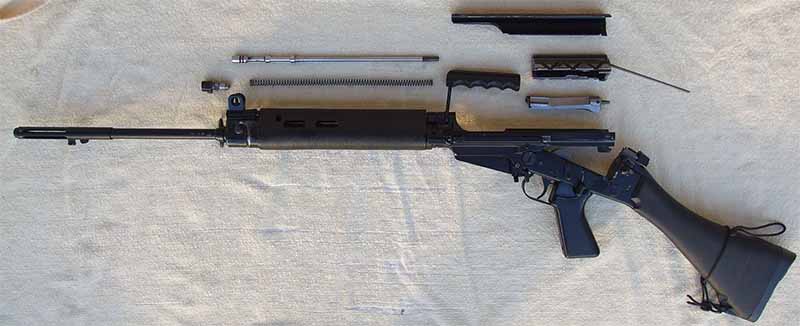
FN FAL Design Principles
The FN FAL operates using a short-stroke gas piston inspired by the Soviet SVT-40. It was a good enough system to be copied by the Germans during WWII with their G43 rifles and was also recycled by the Soviets later in the SKS. It is considered to be a very robust and reliable system, especially in the hands of a trained user who knows how to properly adjust the gas regulator. When the FAL’s gas is properly tuned for the ammunition, environment and weapon condition, it is extremely reliable and pleasant to shoot. The regulator is adjustable enough to let the rifle run reliably even in cold conditions with weak ammo and a dirty rifle, or to have minimum felt recoil with hotter ammo and a clean gun.
Despite the gas regulator, the FAL’s recoil is still a lot to manage in full auto, as is true of any full-power rifle. Because of this, most countries to adopt the FN FAL did so as a semi-automatic only rifle, sometimes opting to adopt a second LMG-configuration FAL in select-fire as a support weapon alongside it. If adopted in its original .280 British guise, there’s no question that all nations would have retained the rifle’s select-fire capabilities.
In its standard infantry rifle configuration, the FN FAL sports a 21-inch-long barrel and feeds from 20-round box magazines. Some later variants would also incorporate folding stocks. Depending on their country of origin or place of adoption, FALs can also feature bipods, carry handles, extended mags and different barrel lengths and handguards.
The greatest distinction between different FN FAL variants is the spec which they were built to, however. There are generally two patterns of FAL—metric and inch. Metric-pattern guns trace their roots back to the original Belgian-made FN models, while inch-patterns are derived from the British L1A1 SLR variant that would be used in Commonwealth nations like Australia and India. Even the magazines between these two patterns are not interchangeable, so be aware of this detail when shopping for a FAL for yourself.
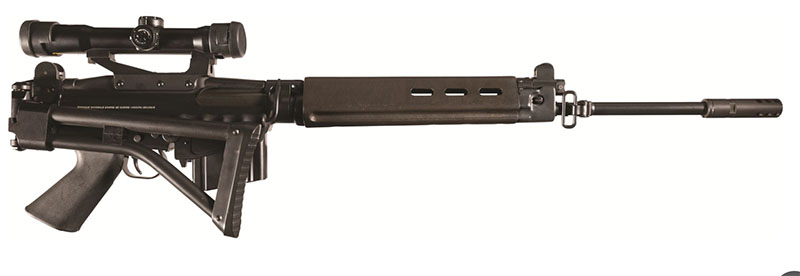
Around The Globe
From the Mau Mau Uprising to the current conflict in Syria, from the professional armies of the United Kingdom to guerrilla forces and mercenaries, the FN FAL has seen some action. Designed to function reliably in the frozen tundra of the Soviet Union, it also performed admirably from the wet jungles of Vietnam to the arid African bush, seemingly only falling short in very sandy environments. Despite the reliability issues experienced in the desert, the FN FAL can still be found being used in the conflicts in Syria, Libya and Yemen.
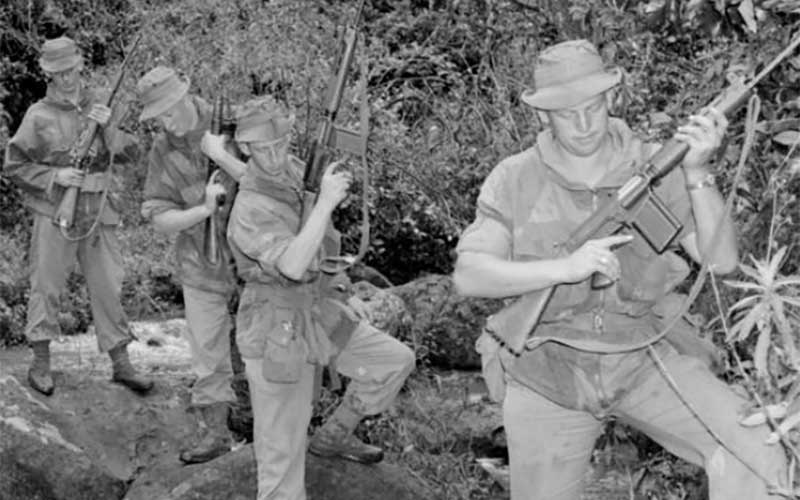
The most notable conflicts in which the FN FAL was prominently featured were the Cuban Revolution, Vietnam War, the Rhodesian Bush War and the Falklands War. Since its invention, the FAL has been adopted by over 90 countries, used by several non-state actors and produced by at least 10 different nations.
Today, the FN FAL is still the standard infantry rifle of several poorer nations and serves as a police rifle for some others who had enough to spare. Otherwise, it is still commonly used by guerilla forces as well as civilian sports shooters.
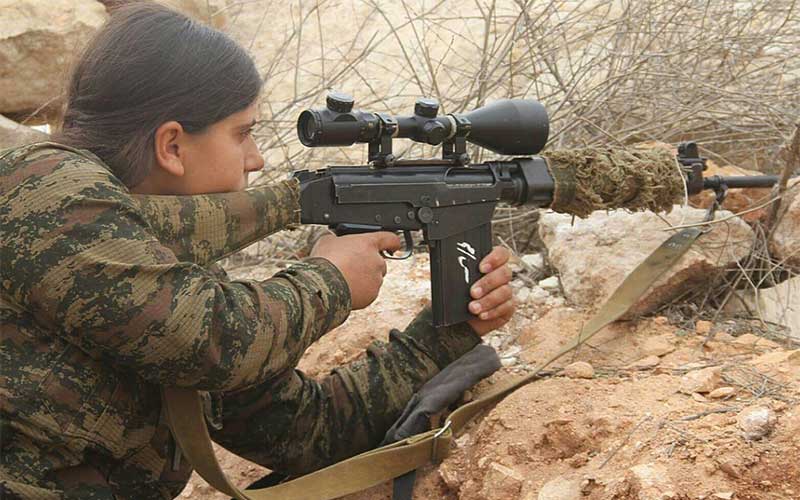
Owning A FAL Today
For those Americans who would like to own an FN FAL, there are two basic paths one can go down depending on where one’s interests lie. For those who appreciate military history or accurate clones, there are a variety of different FAL variants available on the secondhand market ranging from original Belgian examples to Commonwealth SLRs. Unfortunately, it has been quite some time since any FALs were imported and those who would like an interesting foreign-made rifle are limited to the used market and kit builds.
The more practical approach in 2021 is to buy one from America’s premier FAL manufacturer—DS Arms. DSA FALs come in a variety of flavors ranging from traditional to modern tactical and everything in between. If you’re in the market for a FAL to shoot, this is the best place to start.

The history of the FN FAL is a long and complicated one. Its fingers are stuck in everything from post-WWII geopolitics to Cold War proxy conflicts, and its development process highlights some of the diplomatic difficulties experienced by NATO in its infancy. The FAL as it was adopted was never meant to exist in the eyes of its creator, but it nevertheless went on to be one of the most successful, widespread and influential military rifles ever invented.
Its unintended use of the 7.62x51mm cartridge sparked the battle rifle trend that would define NATO small arms until the Americans began experimenting with 5.56 in Vietnam. Almost as iconic as the Kalashnikov, the FN FAL has become a symbol intrinsically associated with the ideas of freedom, democracy and anti-communism, and in Western-allied nations, it became almost as ubiquitous as the AK as well. Today, the FAL is still serving dutifully in the hands of soldiers, police, guerillas and hobbyists, and it will continue to do so for decades to come.
More On Battle Rifles:
- The FN-49: The FN FAL's Grandather
- Classic Battle Rifle Imports From Springfield Armory
- The M1 Garand: America's Original Battle Rifle
- The M14

Next Step: Get your FREE Printable Target Pack
Enhance your shooting precision with our 62 MOA Targets, perfect for rifles and handguns. Crafted in collaboration with Storm Tactical for accuracy and versatility.
Subscribe to the Gun Digest email newsletter and get your downloadable target pack sent straight to your inbox. Stay updated with the latest firearms info in the industry.

![Best Concealed Carry Guns In 2025 [Field Tested] Wilson Combat EDC X9S 1](https://gundigest.com/wp-content/uploads/Wilson-Combat-EDC-X9S-1-324x160.jpg)


![Best 9mm Carbine: Affordable PCCs [Tested] Ruger Carbine Shooting](https://gundigest.com/wp-content/uploads/Ruger-Carbine-Shooting-100x70.jpg)
![Best AR-15: Top Options Available Today [Field Tested] Harrington and Richardson PSA XM177E2 feature](https://gundigest.com/wp-content/uploads/Harrington-and-Richardson-PSA-XM177E2-feature-100x70.jpg)

If it had not been for Douglas MacArthur, then Army Chief of Staff, the M1 rifle and presumably its descendants, would have been adopted using the .276 Pedersen cartridge, around which it was designed, practically the ballistic twin of the .280 British. MacArthur’s reasoning was that there was too much .30-’06 caliber ammunition remaining from World War I stockpiles to justify a change in calibers. It was a decision which would have more consequences than his bungled defense of the Philippines in World War II and his equally bungled conduct of the Korean War, which led to a direct confrontation between Communist China and the UN forces, spearheaded by the US.
In addition to the reduced recoil, which would have made marksmanship training far easier, a great deal less strategic material, in the form of copper, tin and lead, would have been used to produce the same number of cartridges as the .30-’06, and have reduced the weight of the ammunition carried by individual soldiers. Also, the length of the receiver of the rifle would be shorter, meaning that the rifle itself would weigh less, and the Garand designed rifle would have used a ten round en bloc clip, rather than an eight.
MacArthur was born in the days of the Springfield .45-70 “trap door” rifle, lived through the adoption of the Krag .30-40 caliber rifle and the Springfield .30-’06. In 1930, when he made his fateful decision, the last cartridge was only 26 years old and was among the most powerful military rifle cartridges in existence. Despite the fact that all the rifles submitted for consideration were chambered for the Pedersen cartridge, he saw no reason to change.
Outstanding comments. General MacArthur’s triumphant parade after being fired covered up a lot of his military shortcomings. He was informed that a Japanese attack was imminent against his land & air forces in the Philippines after the Pearl Harbour debacle & did mostly nothing to protect them.
John Garand designed a box magazine for the M1 but the Ordnance board would have none of it.
I, currently, own three FALs and in the process of building another one.
What can you tell me about an FN-AR I purchased based on the FN-FAR data and have not been able to get much information since. I purchased it new from a highly respected gun shop in MO.
I am about to clean it and ready it for duty and always re-research my firearms before I wring them out.
I have printed manuals and the manual that came with the FN-AR (7.62×51) (.308)